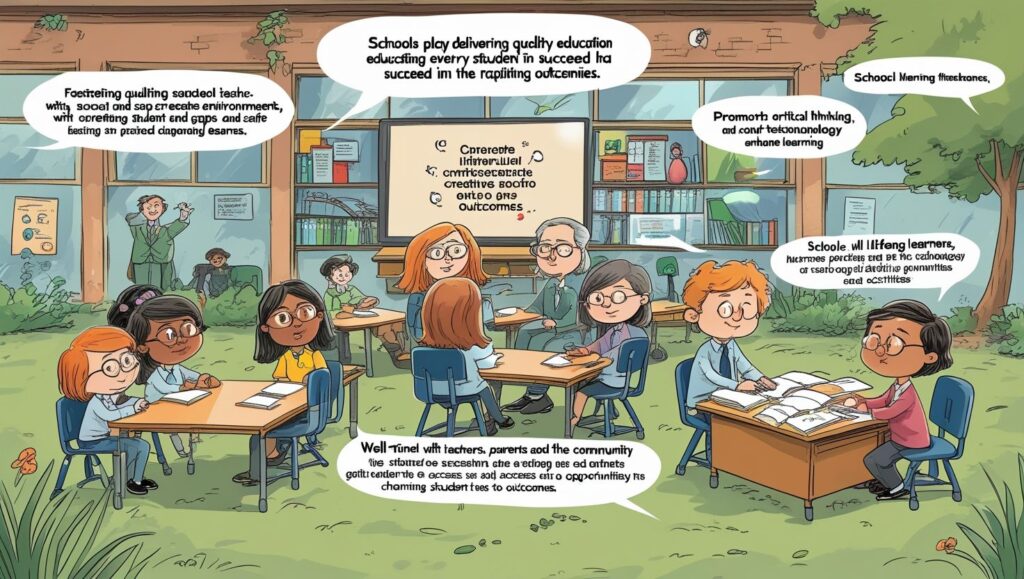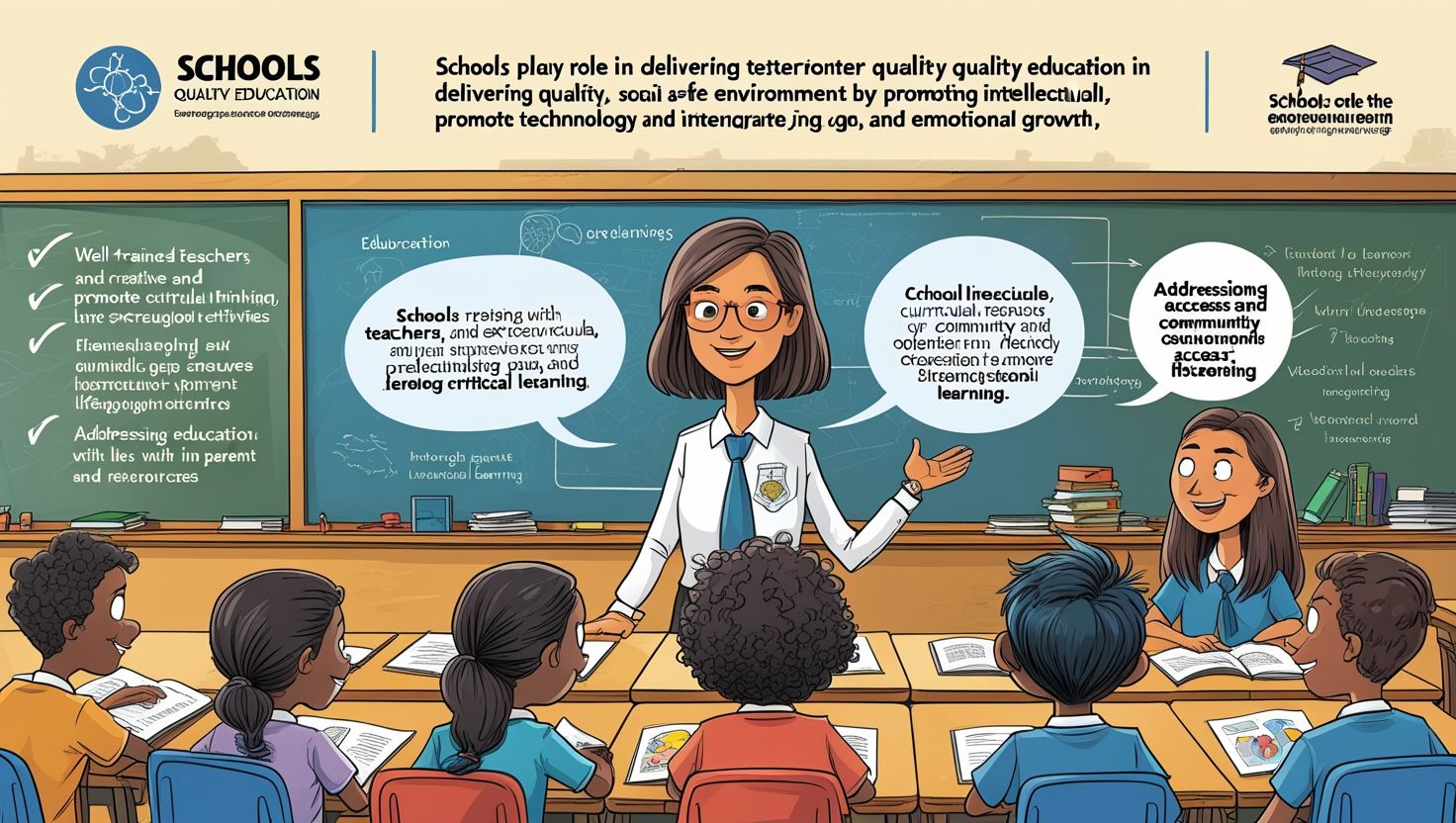The Role of Schools in Delivering Quality Education, Education is the cornerstone of personal and societal development, and schools play a pivotal role in ensuring that quality education is accessible to all. Quality education goes beyond the mere transmission of knowledge; it encompasses the development of critical thinking, creativity, emotional intelligence, and social skills. Schools are not just institutions for academic learning but are also spaces where students learn to navigate the complexities of life, build relationships, and contribute meaningfully to society. This article explores the multifaceted role of schools in delivering quality education and the key factors that contribute to their success.
Creating a Conducive Learning Environment
One of the primary roles of schools is to create a conducive learning environment that fosters intellectual growth and personal development. A well-structured and supportive environment encourages students to engage actively in the learning process. This includes providing adequate infrastructure, such as classrooms, libraries, laboratories, and recreational facilities, which are essential for holistic development. Schools must also ensure that the environment is safe, inclusive, and free from discrimination, allowing students from diverse backgrounds to thrive.
Teachers play a crucial role in shaping this environment. They are not just educators but also mentors who guide students in their academic and personal journeys. Quality education requires well-trained, motivated, and empathetic teachers who can adapt to the varying needs of their students. Professional development programs for teachers are essential to keep them updated with the latest pedagogical strategies and technological advancements, ensuring that they can deliver education effectively.
Promoting Critical Thinking and Creativity
In today’s rapidly changing world, rote learning is no longer sufficient. Schools must focus on nurturing critical thinking and creativity among students. Quality education encourages students to question, analyze, and evaluate information rather than passively accepting it. This approach helps students develop problem-solving skills and the ability to think independently, which are crucial for success in the 21st century.
Creative expression is equally important. Schools should provide opportunities for students to explore their interests and talents through arts, music, drama, and other extracurricular activities. These activities not only enhance creativity but also contribute to emotional well-being and self-confidence. By integrating creativity into the curriculum, schools can help students discover their unique potential and prepare them for a future that values innovation and adaptability.
Fostering Social and Emotional Learning
Quality education is not limited to academic excellence; it also involves the development of social and emotional skills. Schools play a vital role in teaching students how to manage emotions, build healthy relationships, and make responsible decisions. Social and emotional learning (SEL) programs can help students develop empathy, resilience, and teamwork skills, which are essential for personal and professional success.
Inclusive education is a key component of SEL. Schools must ensure that all students, regardless of their abilities, backgrounds, or circumstances, have equal access to learning opportunities. This requires addressing barriers to education, such as poverty, disability, and discrimination, and providing additional support to students who need it. By fostering a culture of inclusivity and respect, schools can create a positive and nurturing environment where every student feels valued and empowered.

Integrating Technology in Education
The integration of technology in education has transformed the way students learn and interact with information. Schools have a responsibility to equip students with digital literacy skills, which are essential in today’s technology-driven world. This includes teaching students how to use digital tools responsibly, critically evaluate online information, and protect their privacy and security.
Technology also offers new opportunities for personalized learning. Adaptive learning platforms, online resources, and virtual classrooms can cater to the individual needs and learning styles of students, making education more accessible and effective. However, it is important for schools to strike a balance between technology and traditional teaching methods to ensure that students develop a well-rounded skill set.
Encouraging Lifelong Learning
Quality education instills a love for learning that extends beyond the classroom. Schools play a crucial role in encouraging students to become lifelong learners who are curious, motivated, and self-directed. This involves teaching students how to set goals, manage their time, and take ownership of their learning. By fostering a growth mindset, schools can help students embrace challenges, learn from failures, and continuously strive for improvement.
Extracurricular activities, such as clubs, sports, and community service, also contribute to lifelong learning. These activities provide students with opportunities to explore their interests, develop new skills, and apply their knowledge in real-world contexts. By encouraging students to pursue their passions and engage with their communities, schools can help them become well-rounded individuals who are prepared for the challenges and opportunities of the future.
Building Partnerships with Parents and the Community
The role of schools in delivering quality education extends beyond the classroom. Schools must work closely with parents and the community to create a supportive ecosystem for students. Parental involvement in education has been shown to have a positive impact on student achievement and well-being. Schools can engage parents through regular communication, workshops, and events that promote collaboration and shared responsibility for student success.
Community partnerships are equally important. Schools can collaborate with local organizations, businesses, and institutions to provide students with access to resources, mentorship, and real-world learning experiences. These partnerships can enrich the curriculum, expose students to diverse perspectives, and prepare them for future careers. By building strong connections with the community, schools can enhance the quality of education and create a sense of collective responsibility for the development of young learners.
Addressing Challenges and Ensuring Equity
Despite the critical role of schools in delivering quality education, there are significant challenges that need to be addressed. Inequities in access to education, inadequate funding, and varying standards of teaching and infrastructure are some of the barriers that hinder the provision of quality education. Schools in underserved areas often face resource constraints, which can limit their ability to provide a well-rounded education to students.
To address these challenges, governments, policymakers, and stakeholders must prioritize investment in education and ensure that resources are distributed equitably. This includes providing adequate funding for schools, improving teacher training programs, and implementing policies that promote inclusivity and diversity. Schools must also adopt innovative approaches to overcome resource limitations, such as leveraging technology, forming partnerships, and engaging the community in education initiatives.
Conclusion
In conclusion, schools play a central role in delivering quality education that prepares students for the complexities of the modern world. By creating a conducive learning environment, promoting critical thinking and creativity, fostering social and emotional learning, integrating technology, encouraging lifelong learning, and building partnerships with parents and the community, schools can provide students with the knowledge, skills, and values they need to succeed. However, achieving quality education for all requires addressing systemic challenges and ensuring that every student has access to the resources and opportunities they need to thrive. As the foundation of society’s future, schools must continue to evolve and adapt to meet the changing needs of students and the world they will inherit.

